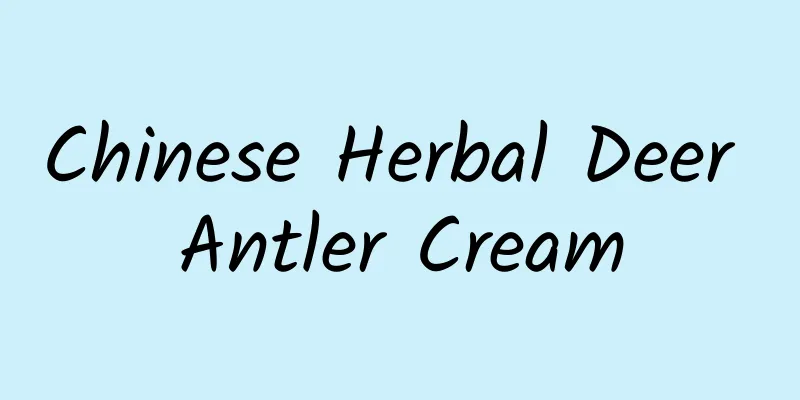Chinese Herbal Deer Antler Cream

|
When it comes to traditional Chinese medicine deer antler cream, I believe many people’s first impression is the antlers of sika deer. That’s right, deer antler cream is made from the horns of animals such as sika deer or horse antlers, which are made from the remaining bone residue after being boiled for a certain period of time. Its main effects include astringency and hemostasis, enuresis and frequent urination, and it is usually ground into powder and taken directly when used. So what is the nutritional value of traditional Chinese medicine deer antler cream? The nutritional value of the traditional Chinese medicine deer antler cream is quite high, but not all people can take it. For example, patients with yin deficiency and hyperactivity of fire are prohibited from taking it. Below I will give you a detailed introduction to the Chinese medicine deer antler frost for your study and reference. Chinese Herbal Deer Antler Cream Protozoa 1. Sika deer, body length is about 1.5m and weight is about 100kg. The infraorbital glands are prominent, the ears are large and erect, and the neck is slender. The limbs are slender, with brown footprint glands under the outer ankle joints of the hind limbs, narrow main hooves, and small side hooves. There is a distinct white buttocks spot on the buttocks and a short tail. The male deer has forked horns, with 4-5 forks when fully grown. The fork extends obliquely forward, and the second branch is farther away from the fork. The end of the main trunk is divided into two small branches. The winter coat of sika deer at the quarantine station is brown, and the white spots are not obvious. The hair on the nose and cheeks is short, with sandy yellow tips. There is a dark brown back line running from the top of the head along the spine to the tail. The white rump patch has a dark brown edge. The belly hair is light brown and the groin is white. The upper side of the limbs is the same color as the body, and the inner side is slightly lighter. The summer fur is thin, without villi, reddish-brown, with prominent white spots arranged in vertical rows on both sides of the spine and the lower edge of the body, with a black dorsal midline. The belly is white, the back of the tail is black, and the limbs are lighter in color than the body. 2. Red deer, which is larger in size, 2 meters in length and weighs more than 200kg. The shoulder height is about 1m, the back is straight and the shoulder and hip height are equal. The nose is bare and the ears are large and conical. The neck length is about 1/3 of the body length, and the hair under the neck is longer. The limbs are long, and the hooves on both sides are long enough to touch the ground. The tail is short, and the male has horns. The brow fork extends forward, almost at right angles to the main trunk. The main trunk bends slightly backward and inward. The horn surface is relatively rough except for the tip, and there is a small circle of tumor-like protrusions at the base of the horn. The winter fur is gray-brown. The mouth and lower jaw are dark brown, the cheeks are brown, and the forehead is brown-black. The outside of the ear is yellowish brown and the inside of the ear is white. The neck and back of the body are slightly yellowish brown with a black-brown dorsal line. The limbs are brown on the outside and lighter on the inside. There are yellow ochre spots on the buttocks. The summer hair is shorter, without undercoat, and is reddish brown. Introduction to medicinal materials Medicinal material: Cylindrical or split into semi-cylindrical pieces, varying in size and thickness. Generally, the frost on red deer antlers is larger, while the frost on spotted deer antlers is smaller. The outer layer is grayish white and dense, while the inner layer is darker and loose with many pores. No smell, slightly bitter taste, sticky tongue feeling. The best ones are those that are neat, grayish white in color and not rotten. Medicinal material properties: [Medicinal material source] It is the bone residue left after making antler glue from the antlers of sika deer or red deer, both of which are animals of the Cervidae family. [Distribution of drug sources] Distribution of animal and plant resources: Mainly produced in Jilin, Liaoning, Heilongjiang, Shandong, Beijing and other places. [Source] This product is the antler blocks with the gelatin removed (the bone residue left over from making antler glue). Produced in spring and autumn, the ossified horns are boiled to remove the gelatin, the horn pieces are taken out and dried. 【Preparation method】Crush before use. [Properties] This product is in the shape of an oblong cylinder or irregular blocks of varying sizes. The surface is grayish white, powdery, often with longitudinal ridges, and occasionally gray or gray-brown spots. It is light in weight and crisp in texture. The outer layer of the cross section is denser, white or grayish white, while the inner layer has honeycomb-like pores, grayish brown or grayish yellow, and is hygroscopic. It has a slight odor, light taste, and feels sticky when chewed. 【Nature and flavor and meridians】Salty, warm. It enters the liver and kidney meridians. 【Functions and indications】Warms the kidney and assists yang, astringes and stops bleeding. It is used for impotence of the spleen and kidney, anorexia, vomiting and diarrhea, leucorrhea, enuresis and frequent urination, metrorrhagia, carbuncle and phlegm nodules. Dosage and Administration: For oral administration: decoct in water, 5-10 g; or make into pills or powder. For external use: Grind into powder and sprinkle. Nutritional knowledge Introduction to Deer Antler Cream: Deer Antler Cream is the bone residue left after making antler glue from the antlers of Cervidae animals such as sika deer or red deer. Sika deer live in mixed forests, mountain grasslands and the edge of forests. Distributed in Northeast China, North China, East China and South China. Sika deer are a national first-class protected animal. Currently, they are relatively small in the wild and hunting is prohibited. They are raised in Jilin, Liaoning, Hebei, Sichuan and other places; red deer live in mixed forests, alpine forests and grasslands, and are distributed in Northeast China, Northwest China, Inner Mongolia and other places. In the ancient times, in the process of making deer antler cream, some people did not extract the deer antler gum, while others added other auxiliary materials. Deer antler frost is in the shape of an oblong cylinder or irregular blocks of varying sizes. The surface is grayish white and powdery, often with longitudinal ridges, and occasionally gray or gray-brown spots. It is light in weight and crisp in texture. The outer layer of the cross section is denser, white or off-white, while the inner layer has honeycomb-like pores, is gray-brown or gray-yellow, and is hygroscopic. It has a slight odor, light taste, and feels sticky when chewed. The best ones are those that are neat, grayish white in color and not rotten. Additional information about Deer Antler Cream: Processing: Take the original medicinal materials, remove impurities, crush them, and store them in a dry container after processing, seal it, and place it in a ventilated and dry place. Deer antler cream is suitable for people who: People with yin deficiency and excessive fire should not take it. Deer antler frost has a salty and astringent taste, is warm in nature, and enters the kidney, liver, and spleen meridians; It is light and astringent; it has the effects of nourishing the kidney and yang, astringing and stopping bleeding; It is mainly used to treat kidney yang deficiency, cold pain in the waist and knees, impotence and spermatorrhea, frequent urination and enuresis; spleen and stomach deficiency and coldness, poor appetite and loose stools, metrorrhagia and leukorrhea, traumatic bleeding, and unhealed sores. Instructions for making Deer Antler Cream: 1. For those with insufficient kidney yang, loss of essence and blood, weakness, dark complexion, impotence, and infertility, it can be used in combination with Cistanche deserticola, Aconitum carmichaelii, Morinda officinalis, and Sichuan pepper. 2. For patients with kidney deficiency, weak sperm gate, nocturnal emission, or leakage of sperm during sleep, it can be used with dragon bone and oyster to enhance the astringent effect. Usage tips: For internal use: decoct in water, 6-10 grams; or make into pills or powder. For external use: appropriate amount, grind into powder and sprinkle. After reading the above detailed introduction to the Chinese medicine deer antler cream, I believe that you all already know the effects and functions of the Chinese medicine deer antler cream. Deer antler cream is a relatively precious medicinal material. Since the sika deer is a first-class protected animal in my country, antler cream is generally made from self-raised sika deer. Deer antler cream has significant effects on symptoms such as cold pain in the waist and knees, cold spleen and stomach, and can also have hemostatic and astringent effects. However, deer antler cream is a medicine after all, so it is best to consult a doctor before taking it. |
>>: What are the benefits of eating betel nut?
Recommend
2021, thank you for your hug
Your browser does not support the video tag 2021 ...
Why do some peaches look good on the outside but have a "bad heart"?
This article was reviewed by Liu Shaowei, Deputy ...
The renovated "Bird International Airport" allows birds to settle down with confidence
Before governance After governance The picture sh...
The efficacy and function of Panax notoginseng saponins
Panax notoginseng is also known as Tianqi. Li Shi...
Wild watermelon seedlings are neither watermelons nor seedlings.
Speaking of wild watermelon seedlings Hibiscus tr...
The efficacy and function of hook-shaped gerbera
Recently, major TV channels have launched various...
It can grow a new head even if it's missing! Why is the "Axolotl" so amazing?
If you love to visit flower and bird markets, you...
How many grams of angelica can be taken at one time
Chuanxiong is a common Chinese medicinal material...
What are the benefits of soaking dandelion in water?
In daily life, many people are accustomed to drin...
Where in China is the winter warm enough not to need heating?
The cold wind is blowing People always yearn for ...
If you always feel waist discomfort, is it kidney problems? These 7 lifestyles can help prevent chronic kidney disease
Doctor, doctor, oh no! I saw online that Every 10...
The efficacy and function of the root of Rock Bean Vine
The root of the Rock Bean Vine is a very common m...
Will bubble gum stick to your intestines? Will watermelon seeds grow small watermelons in your stomach? Did you believe these words when you were a child?
This article is produced by "Science Facts&q...
New research comes out! Who lives longer, fast or slow walkers?
In 2019, the Mayo Clinic Journal in the United St...
What are the effects of lantern grass
Speaking of lantern grass, many people may not kn...









